Subtleties of care
In order for the violet to delight its owners with abundant and bright flowering all year round, it is required to carry out constant feeding and regular watering. The plant should be irrigated whenever the potted soil is about a third dry. For irrigation, you should use soft, settled water, always at room temperature. The liquid should be poured evenly under the spine, preventing moisture from entering the sheet plates. Otherwise, the leaves change color and even begin to rot.
Experienced flower growers advise to organize watering "Bullfight" in one of the following ways:
- upper - in this case, a watering can with an elongated spout is used;
- lower - in this case, the container with the plant is placed in a basin filled with water by 2/3, and left in this position for half an hour so that water penetrates into the peas through the drainage holes;
- wick - with this option, the flower itself regulates the water level in the substrate, gradually pulling it along the cord-wick: one end of it is placed in a container with water, and the other is lowered into the ground.
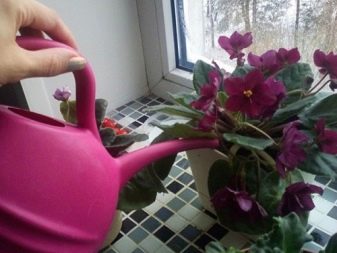
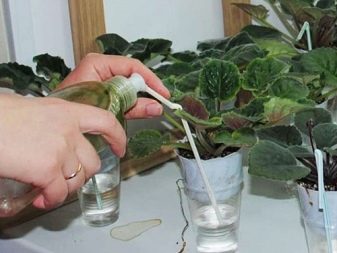
Every 10-15 days after watering, the plant is fertilized. At the time of growing green mass, the flower needs nitrogen, at the stage of bud formation and at the stage of flowering, it is better to use fertilizing with phosphorus and potash complex fertilizers. Keep in mind that only healthy flowers with a developed root system should be watered. If the plant is transplanted or has been ill, then feeding should be interrupted for 2 months.

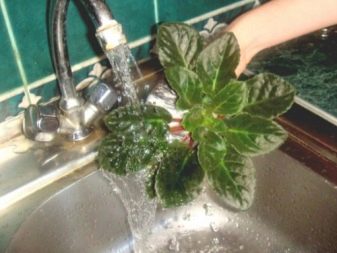
For information: how new varieties are obtained
To get new colors in violets, new flower shapes, you need to be patient and study the advice of breeders.
First, you need to understand how Saintpaulia reproduces by seeds, try to grow new plants, collecting these tiny "specks of dust" from the mother violet in time. And only after a small seedling blooms (this will not be earlier than in 9-10 months), you can be puzzled by hybridization.
To obtain a new variety, two plants are needed: from one you need to remove the pollen (this is the father's) and transfer it to the pistil of the other (this is the mother's). This is how the variety Bullfight was obtained. It would seem that everything is simple, but it must be done with jewelry at the moment when the pollen of the father plant is ripe and when the mother plant is ready (this is evidenced by a drop on the pistil). Moreover, you need to remove the stamens from the mother, so that it does not pollinate itself. And if these processes do not coincide in time, what then? You need to learn how to preserve pollen, which is also not at all easy.
Then, after successful pollination, you need to wait until the seeds ripen (from five months, if the process is started in spring, and up to nine months, if in autumn). The peduncle, on which pollination took place, first increases in size, then curls a little, then begins to dry out.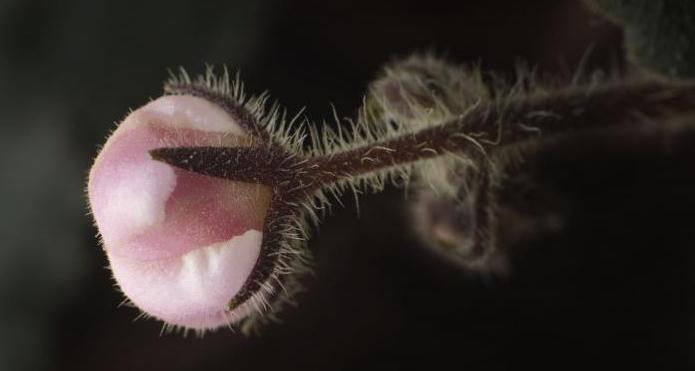 The box with seeds must be removed, dried, and only then opened. Wait two or three months, and only then plant the seeds, pouring them onto a wet soil mixture, covering it with glass or a bag, that is, creating a greenhouse regime.
The box with seeds must be removed, dried, and only then opened. Wait two or three months, and only then plant the seeds, pouring them onto a wet soil mixture, covering it with glass or a bag, that is, creating a greenhouse regime.
Tips for a beginner violet breeder
The beauty of flowering violet hybrids Fight of bulls, their intense color, ease of propagation by cuttings often cause an inexperienced grower to have a keen desire to create a new variety himself. But he is trapped not so much by the difficulties of the process itself, as by the lack of systematization skills, that is, paperwork. Therefore, it is still easier to reproduce proven varieties, you can even try to root flower stalks (another way to reproduce Saintpaulias) - this is still better than getting a new hybrid, not knowing what qualities it should have.What if there was an accidental crossing and the plant will not be able to convey the necessary qualities? And if dominant and recessive features were not taken into account? What then to do with the plant? Is it a new variety or not?
Only the ability to self-organize will help you become a real breeder, and not just an amateur florist.
Optimal conditions
Saintpaulias of this variety are usually kept under artificial light, as well as on windows located from the north, north-east or north-west. This variety does not tolerate direct sunlight, but at the same time, it needs illumination for 12-15 hours a day, therefore, the deficit of natural insolation must be compensated for with special phytolamps or fluorescent lamps of the yellow spectrum. If the saintpaulia is placed on a window, then it must be turned in different directions towards the window 2-3 times a day. Thanks to this, the rosette is formed symmetrical and neat.
The optimum room temperature is 18-25 degrees. The flower does not tolerate frequent drafts and low temperatures. The humidity level should be maintained at a level of 50-60%, however, it is not recommended to increase it artificially by spraying the plant. It is better to turn on a humidifier or at least a room fountain for several hours a day. If neither one nor the other is in the house, you can occasionally spray water from a spray bottle at a distance of 1.5-2 meters from the flower.
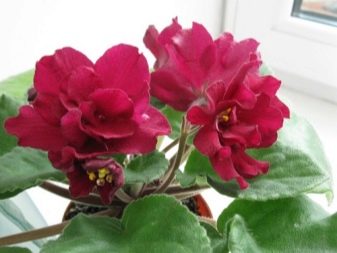
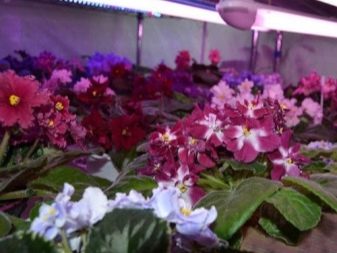
Where and when did the uzambar violets come from?
Among the subtropical plants, there are many interesting small and huge flowers
Walter von Saint-Paul, who served in Africa in 1882, was lucky to pay attention to an interesting specimen, to collect seeds and send them to his homeland (in this case, to Germany). His father Ulrich von Saint-Paul gave them to Hermann Wendland, a botanist (it was not difficult - the baron was president of the German Dendrological Society)
Wendland grew a flower from seeds, described it (1893) and named it Saintpaulia teitensis in honor of his father and son.
Industrial cultivation of Saintpaulias was bought out by E. Benary, but only in 1927 began the enthusiasm for this plant as an indoor plant in the United States. By 1949, breeders all over the world had bred one hundred varieties of Saintpaulias. The plant is popular among simple florists and breeders. The demand is unchanged, especially since today more than three thousand varieties are already known. Violets of Russian breeders occupy a worthy place among varietal hybrids; red terry violets of the breeder Elena Korshunova are in special demand.

Planting and breeding
The violet is propagated in three ways:
- With the help of a daughter outlet;
- With the help of a sheet;
- With the help of seeds.
The latter method is used only by breeders and is practically not available to ordinary flower lovers.
To get daughter rosettes, the old violet is cut and rooted, but the stump that remains after the cut is not removed. Daughter sockets appear on it, which are later re-rooted into separate pots of small size.
Leaf propagation is carried out in the standard way:
- Cut off the leaf.
- They are immersed in the ground by 2 cm and slightly squeeze the ground around the cutting.
- Cover with a glass jar and watered lightly if the soil is dry.
Plant care is about timely watering and the right habitat.
- Saintpaulia already in May does not tolerate direct sunlight and can burn out if they fall on it;
- The soil between waterings should dry out by 1/3 of the capacity;
- Fertilizers are used specialized for Saintpaulia, or if there are no such fertilizers, then they can be used for other flowering plants.
Diseases and pests
The best prevention of infection of Saintpaulia with bacterial and fungal infections is compliance with the standards of flower care and the creation of optimal conditions for its growth and development.Competent watering, fertilizing, following the transplant technology help to increase the immunity of the flower and increase its ability to resist dangerous viruses and other pathogenic microorganisms.
If the plant is waterlogged, lacks light, or is in a too cold room, then it often becomes a victim of powdery mildew, late blight or all kinds of rot. In the earliest stages, the flower can still be saved. To do this, you need to completely remove all affected parts of the plant, and then transplant the Saintpaulia into a new container with fresh substrate.
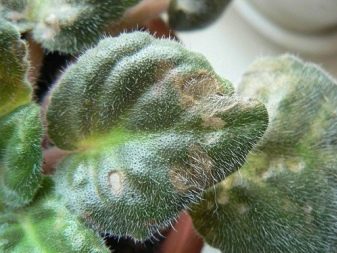
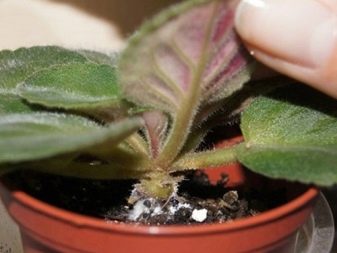
The following insect pests pose the greatest danger to the "Fight of the Bulls" violets:
If insects are found, it is necessary to immediately wash the plant with a solution of laundry soap, and then treat it with an antibacterial composition. The most effective drugs are Fitoverm, Actellik and Fufanon.
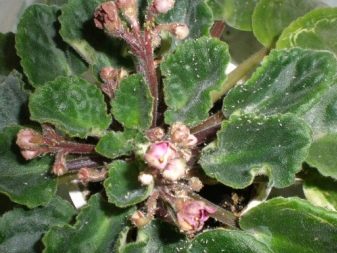
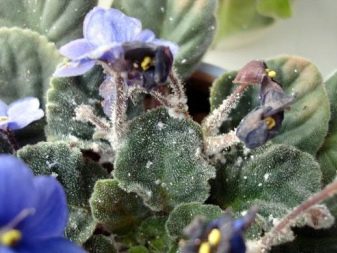
Reproduction of Saintpaulias
To obtain the declared variety, you need to know how to propagate, how to plant a violet later, how to care for it to bloom constantly.
There are three ways to get offspring from violets. Bullfighting can be done in three ways: by rooting a daughter rosette, growing from leaves, by seeds. The first two are available to any grower, and the third is used by breeders.
To get a new plant from the outlet, you need to grow a stepson on a violet. How? Violet variety Bullfight rarely develops daughter rosettes, so she needs to be forced to release her stepson. To do this, the growth point is pinched at her. Violet will begin to create new points of growth - these are future outlets. When they are 2-3 cm in size, they are carefully cut from the violets and planted in a previously prepared wet mixture in a pot. Cover with a plastic bag to maintain constant humidity. After 2-3 weeks, the rosette will give roots, evidence of this is the growth of the rosette leaves. The package can be removed.
The most affordable way for breeding bullfight and bullfight gold hybrids is leaf cuttings. In a strong adult plant, a leaf is cut from the second row of the rosette along with the petiole. Then it needs to be cut with a thin (disinfected) blade at a distance of 2-3 cm from the base of the sheet. Place the prepared leaf in warm soft (possibly distilled) water so that the base of the cutting does not rest against the bottom of the container. English breeders advise placing the leaves on the edges of the plate: they lie free, and in the case of several varieties, you can place the plates under the bottom of the plate. In transparent containers and plates, you can see when the roots appear. It is not necessary to wait until they become large: for good rooting, their length of one and a half to two centimeters is enough
The stalk is carefully buried in moist, loose soil (or sphagnum moss), after three weeks, green leaves will appear - this is the future rosette. When they grow up to two centimeters, the mother leaf can be cut off (first half, then after a few days the leftovers)
If the room temperature is low (below 20-22 degrees), rooting may not occur. For the same reason, you cannot put a pot with a shank on the windowsill: during the day here, direct sunlight overheats the soil mixture, and the night air cools.


